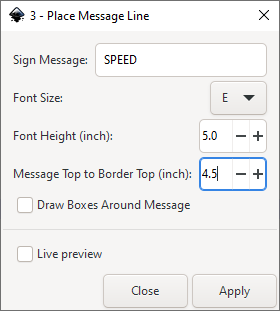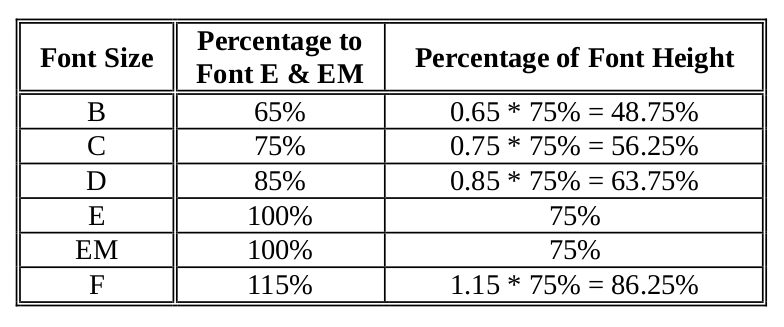Place Message Line Tool
The Place Message Line tool is the core program of the OpenSignTool package. It is intentionally designed to be simple. We will discuss some advanced features in this article.
Message Tool
The Place Message Line supports highway gothic font published on the Standard Alphabets for Traffic Control Devices document. The tool distinguishes uppercase and lowercase letters. Most regulatory signs use uppercase letters only. Sign designers need to enter uppercase letters on the tool dialog (e.g., “SPEED”).
The Place Message Line tool provides the core functionality of the OpenSignTool package. The program places a line of sign message in highway gothic font onto the drawing canvas. The Inkscape itself does not have this function built in, in other words an engineer cannot draw traffic signs in Inkscape without a tool like this.
When drawing a speed limit sign, an engineer specify the sign message such as “SPEED”, font size (B, C, D, E, EM, and F), font height, and a distance from message top to sign top edge. If the option Draw Boxes Around Message is chosen, the program will draw a box around each character of the message.

The OpenSignTool software package comes with a file containing all the standard sign character paths. For each character, a second file contains the letter dimension and left and right hand side spaces around it. This character shapes, sizes, and space values are reproduced from the 2004 Standard Highway Signs book. When a line of message is placed onto a sign, the program will read those files and place each character according to the specification
The MUTCD and Standard Highway Sign book are not very clear on some aspects of sign message design. The next two sections will discuss some of those issues and how they are addressed in the tool.
Spaces between Message Words
The standard does not specify the horizontal distance (space width) between two words on a line of message. The 2012 Supplement to Standard Highway Signs book does not apply a constant space width value. For instance, the space in the message “STATE LAW” is 4 inch for 4D size message on sign R1-9, but the space is 3 inch for 4D size message “HOV 2+” on sign R3-12.
The OpenSignTool handles the spaces between message words in two ways. The first method is an automatic process that the program decides the space width. If a user simply input “STATE LAW” on the Sign Message textbox, the program automatically looks up a value from below table and calculates the space value (between words “STATE” and “LAW”) as a percentage of font height.

The percentage values in above table are derived from measuring the width of 26 uppercase characters of a font size. The width of uppercase D characters is about 85% of the width of E, so the space width for font size D is 85% of E. In figure below, the space between STATE and LAW 2.55 inch is calculated as 4 inch (font height) multiplying a factor 63.75%.
The percentage values in the table and are implemented in the program. The numbers seem to achieve a satisfactory result that is close to the standard sign layouts in the 2012 Supplement to Standard Highway Signs.
The second method is to specify a width value between two words such as “STATE|4|LAW” in the message input textbox. The program will read the bar symbol and interpret the number 4 as 4 inch space between two words and place the two words 4 inch apart.

Fractions
Fraction like the 1/4 in “1/4 MILE” message often appears on guide signs. The MUTCD section 2A.13 requires that the overall height of the fraction shall be 1.5 times of the height of an individual number within the fraction, but it does not specify the spaces between characters or horizontal placement of numerals. Signs on the roads often have inconsistent fraction layouts.
The Place Message Line tool can automatically handle fractions. A sign designer can simply input “1/4 MILE” in the Sign Message textbox to get a message line “1/4 MILE”. The program decreases the fraction width if the numerator is 1, and moves the denominator close to the forward slash if it is number 4. Figure below shows the most common fraction combinations. If the message line contains a fraction and a word, the program will vertically align the center of the fraction with the word. The figure below shows the rending of common fractions on signs.
